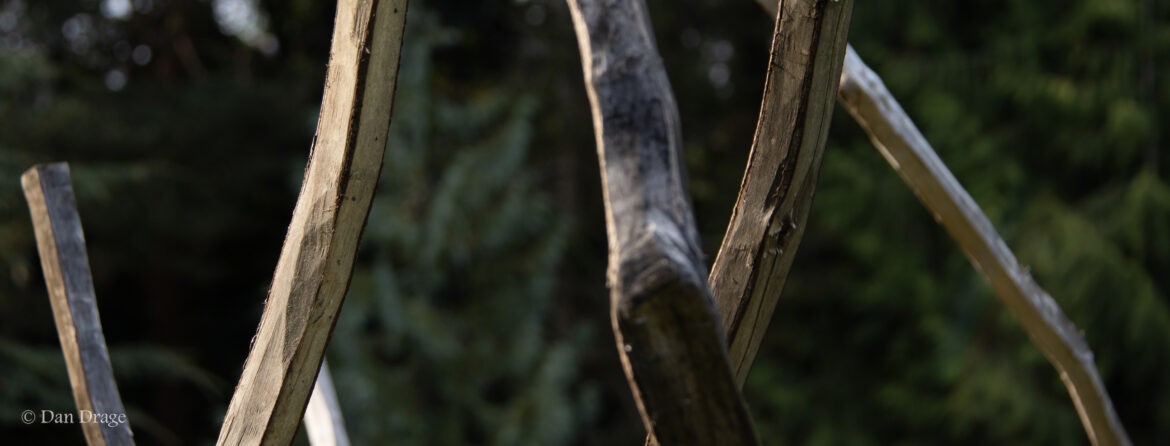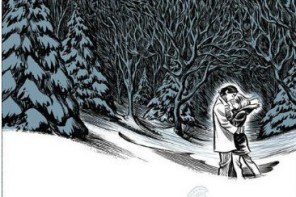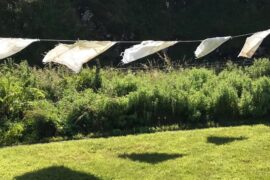Of the many questions Dan Drage evokes in Gathering Surface, the relationship between human productivity and nature occupies a privileged place. Each of the types of work—“pit and mounds,” “clusters,” and “sleeping fir”—speaks to some imaginable boundary between artifacts and their natural setting, to the reliance of art on environment. This reliance becomes visible in the dynamic interchange of Drage’s installation with its surroundings of the St Andrews Botanical Garden. Nature slowly overtakes art; reclaiming what once belonged to the world.
On the one hand, this process reveals the frailty of humanness in the face of natural forces. All the effort for shelter and survival against the world is concentrated in these three types of work, as they gently lose their artifactual stability for the sake of ecological participation. Tearing art from the safety of exhibition rooms and museum halls exposes its finitude. On the other, Drage’s art draws on a certain essential feature of the “natural world” buried deep in our modern social imaginary. There is a temporal permanence to nature. It has been here long before humanity and their creative enterprises; and it will outlast them just the same.
An emphasis on temporality is a common feature of Land Art. Robert Smithson, for example, drew heavily on temporality, primarily from George Kubler’s influential book, The Shape of Time.2 Smithson’s Spiral Jetty is a testament to the incessant processes of minerals as the boulders are overtaken by salt deposits, turning the entire work from shades of gray to white.2 Even in those iconic works which bring spatiality to the fore, such as Richard Long’s A Ten Mile Walk, space is reduced to a cartographical line. A distance between two points, without width, without volume. The diminution is made more explicit in Dennis Oppenheim’s Time Pocket, which, while consisting of a physical line, sought to erase the spatial aspect altogether.
Space seems to be forgotten, yet, at the same time, everywhere assumed.
In fact, of the “several unifying threads” indicated on the introductory plaque of Gathering Surface, “the relationship between time and the world” is the most pronounced, standing alongside the humanly initiated “investigation into soil” and the reductive tendency to view nature as “material.”
Space is certainly presupposed in Gathering Surface. Drage’s descriptions includes spatial terms such as “boundaries,” “vertical gathering,” “horizontal postures,” “surrounding area,” “surface,” and “lines.” Yet, unlike time—a word that appears on half of the installation plaques—space itself receives no explicit indication. Perhaps the imperceptibility of time requires more attention. Or, perhaps, the slow churn of its passing keeps our attention. Either way, the spatiality of Gathering Surface is in no way immediate. It requires work to become present. The first of these spatial terms is telling, acting as a synecdoche for those that follow. For the assumed spatiality behind the installation becomes perceivable only at points of collision. Space is gathered at the boundaries.
Spatial Dimensions
Art in the Garden
The first collision is between Drage’s art and the space of the Garden. This collision perhaps more directly indicates the general intent of Land Art than any of the points to follow. Here, “art” is distinguished from “land,” human productivity from nature. Yet, this is equally one of the more subtle collisions.
The Botanical Garden can evoke an experience with nature, a reprieve from the aesthetics of the city. This evocation is appropriate in so far as the gardens are filled with thriving plant-life, the presence of which offers a different world than the surrounding labyrinth of roads and buildings. Its inappropriateness, however, is discerned in the simple fact that very little of the Garden has grown outside the hands of its gardeners. Plant-life has been relocated, done so for the sake of a heightened grandeur of nature.
The unnatural setting of the Garden is ascertainable through the spatial organization of its plants. There are simply too many varieties, placed too closely together, in too aberrant arrangements to be “natural.” It is an “art of appearances that imitate appearances.”3 Ironically, its presence likely only fools the city-dweller, those who have not been attuned to the wildness of nature—in both its beauty and terror. The manufactured boundary of the Garden’s walls and fences should have been a clue. One must cross a stiff line to experience organic forms.
Drage’s work challenges this un-natural setting by making explicit what the Garden hides in plain sight. The Rhododendron Clusterhighlights this collision, stating an initial step as “reinterpreting…human shaped lines in the Garden” so that they “can then be recognized as participating” in the conversation of boundaries. While the installation’s description limits this hermeneutical transformation to “machine-cut lines” (i.e., “fences, buildings, steps”), the principle can easily be extended to the larger spatial organization. Artistic endeavors of humans often (if not always) result in a different spatiality; a seemingly more “perfect” proportionality.
The Rhododendron presents this idea in a modified form. The natural path of these salvaged branches is preserved, only their overall shape is leveled off on all sides. The “bush” is transfigured into extruded cubes. It is more obviously a product than the plantings in the Garden, without losing its natural foundation, its organic form. It re-presents the relationship between art in nature in such a way that the entire context of the Garden is re-imagined. Alongside whatever other meanings this μετάνοια [“change of mind”] may include, it draws out the artificiality of the culture landscape. A subversive aesthetics becomes a more honest presentation of art’s distinction from its natural setting.
Ways of Travel
The second collision also comes from the interaction of the spatial organization of the Garden, but this time with placement of each of Drage’s installations within the Garden’s limits. The particularity of the art has an impact on the movement of the visitor, on their path of travel. This collision happens more obviously as the Charred Cluster and Beech Cluster flank a hill descending into the meadow, the former at the top, the lower at the bottom. As visitor’s encounter the first, the second is already in view, inviting (if not all but compelling) descent.
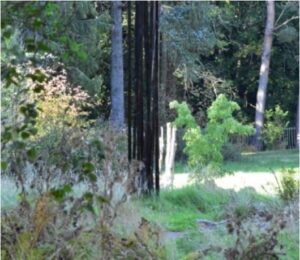 Once in the meadow, the Rhododendron Cluster continues this movement, standing in view of the Beech Cluster. This arrangement draws the visitor into a forgotten corner of the Garden, where they discover the Sleeping Fir, tucked behind a Lebanese Cypress tree, otherwise hidden from view of the main pathways. As the arrangement of the installations in the meadows accumulates, its rhythm carves a new path through the field of grass. The art charts a course through the Garden.
Once in the meadow, the Rhododendron Cluster continues this movement, standing in view of the Beech Cluster. This arrangement draws the visitor into a forgotten corner of the Garden, where they discover the Sleeping Fir, tucked behind a Lebanese Cypress tree, otherwise hidden from view of the main pathways. As the arrangement of the installations in the meadows accumulates, its rhythm carves a new path through the field of grass. The art charts a course through the Garden.
A more modest form of this collision occurs along the main path at the top of the hill, in the approach to Charred Cluster. Opposite from this more imposing piece quietly lie the Grove Pit-and-Mound Pairs, a set of three shallow excavations and their corresponding mounds of dirt. These Pit-and-Mounds are placed several feet from the main path, close enough to catch a glimpse, but far enough to suggest moving into the grasses of the grove. To gain an adequate view of these pieces is to deviate from the common lane of travel. They, in a sense, promote adventure, at least presenting the possibility of altering how the rest of the Gardens is navigated. 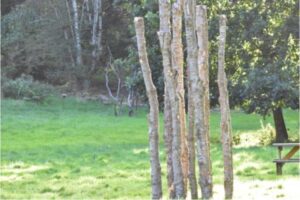
This deviation is not entirely unwarranted by Drage’s intention “to gain a different view of the Garden,” as stated on the Grove Pit-and-Mound Pairs. While the artist hoped this would occur by the visitor laying down in the holes, “interacting with the soil” through physical touch, the deviation off the trail is perhaps enough to invoke such a transformation.
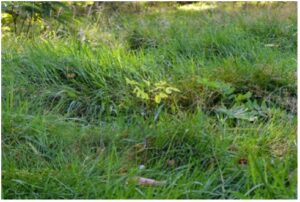

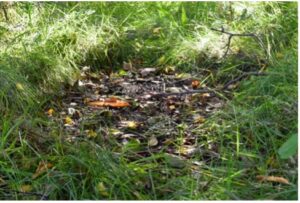
Sun & Shade
Yet, the interaction of the placing of Drage’s pieces with the space of the Garden extends beyond human imagination and movement. There is an intimate collision within the dynamics of nature itself, concerning the spatiality of shade and sunlight. Seemingly unknowingly, Drage placed the three Grove Pit-and-Mound Pairs in varying amounts of shade. Over the summer months, plant-life has reclaimed the demarcated spaces to different degrees, corresponding to the amount of light each “pit” receives.
In the pit furthest to the north, which is in near full sun during the summer, the grasses have reclaimed the excavated space. It takes a considerable degree of effort to even locate this pit. Amongst the thriving grasses, a small Black Locust (robinia pseudoacacia) sapling has taken root, slowly overtaking the presence of the installation. In the next pit, placed much more in shade, a thistle plant grows among various malnourished ventures of reclamation.
While not as developed as the first, its symbolic meaning makes a strong statement in the Scottish landscape. The last pit, tucked away under a group of trees to the south of the grove, lies in full shade. The dirt remains bare, without enough sun for life to spring forth.
Spatially, nature is not monolithic. Just as there are gradations of artistic endeavor, so there are in organic growth. The relationship between the sun, trees, and ground presents its own harmonious proportion. Giving life in some areas; restricting it in others. This harmony is powerful; enough to demand respect even from the un-natural organization of the Garden. It remains a question, however, if this spatial dynamic is enough in itself to become perceptible. Drage’s art brings nature’s soft touch to our awareness, revealing that not only does art expose other human modes of production, but puts us in a more intimate relationship with nature.
Ubiquity & Porosity
As the various dimensions of spatiality compound, the ubiquitous nature of spatiality itself comes into frame. Here space collides with perception. This occurs in both a positive and negative sense: The first is an absence laying in plain sight; the second, a presence hidden in the earth.
Negatively, the three cluster installations incorporate space, or “atmosphere” as Drage names it, within their overall presence. Space permeates the clusters, separating their “branches,” allowing room for their density to breathe. This creates allusions to nature; at times, to the sway of the grasses, at others, to the radiance of a low sun through the trees of a forest. The negative space varies per cluster, increasing from Charred Cluster to Rhododendron Cluster to Beech Cluster, although the effect of the ubiquity of space remains consistent. More space, more “atmosphere,” does not necessarily result in more of a reference to nature, more of a transformative impact on the visitor. It is quite the opposite. The visible features of the Clusters grab the air, collect “atmosphere.” Perception lives from this dialectical tension.
Positively, space permeates Sleeping Fir in the form of “soil.” This space is filled, seemingly solid, smothering the installation. All the same, as the clusters jut out from the soil into the sky, Sleeping Fir infiltrates the ground. It has an “ability to suggest a porosity” in its positive space, “in the boundaries between atmosphere, surface, and that which lies underneath.” It reveals that even a material “mass” of earth shares spatial commonalities with its other great counterpart. It brings to perception that even within the ground there is room to move, so to speak. Neither “air” nor “ground” is as monolithic as it first appears.
Gathering of Space
The porosity of space, the gradations of both human creativity and natural growth, affords a vision of possible harmony between humanity and nature. It provokes a search for places where humans can dwell that does not exact as much expense from the ecological realm. It shows that these two realms are not delineated by a precise limit, that they are not competing in a zero-sum game, but are rather separated by a boundary, itself porous.
This view of the human-nature relation, however, must account for particularity. It must seek for places within space. And, particularity is the activity of art.
Art thereby brings forth space. It gathers at places.
In Drage’s art, the Garden is gathered from its boundaries with wilderness; the visitor to certain paths of travel; understanding to the nuances of nature; perception to a new meaning of presence. It gathers a new imagination at each place, and, ultimately, a new way of being in the world. Or, at least to its particular possibility.

